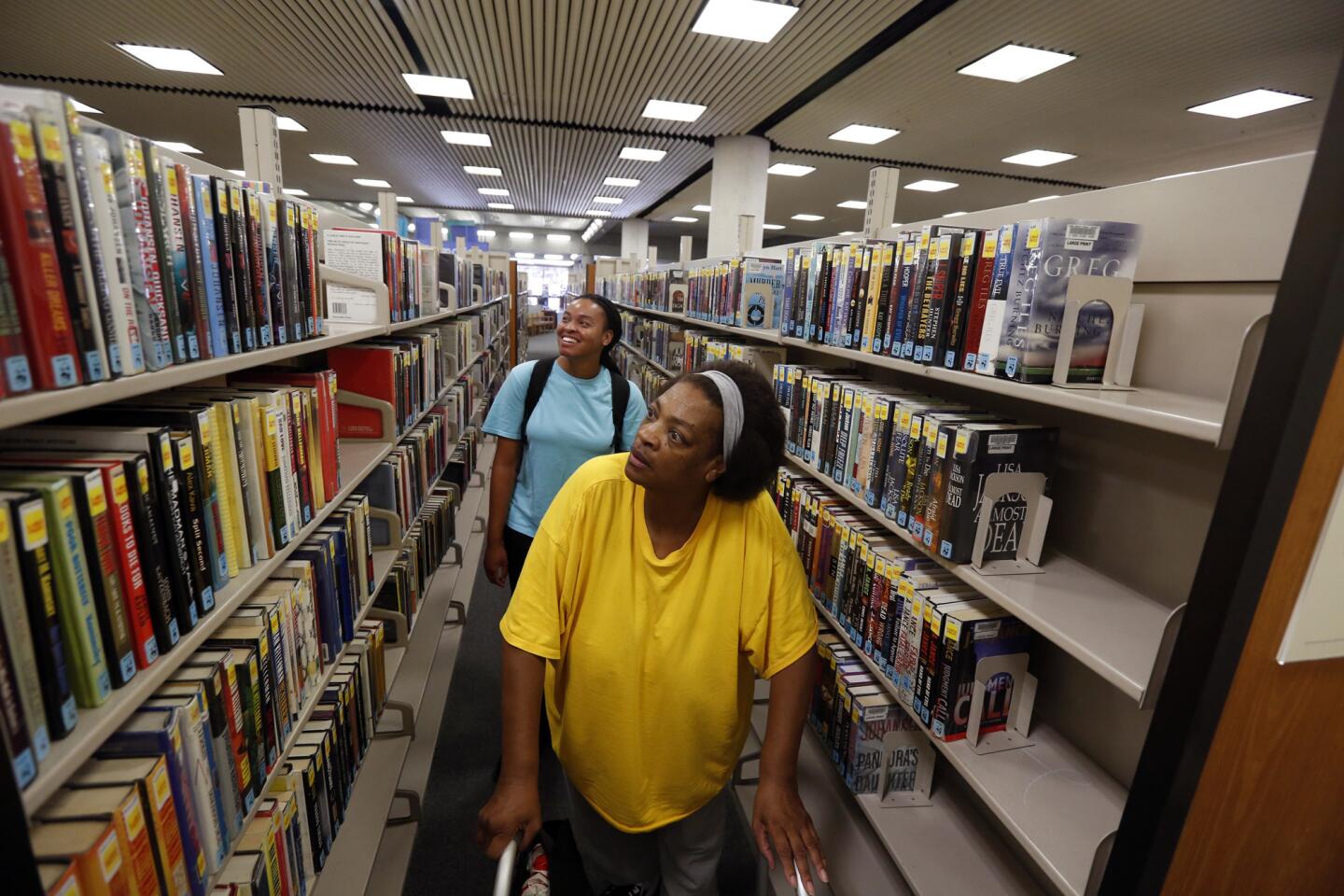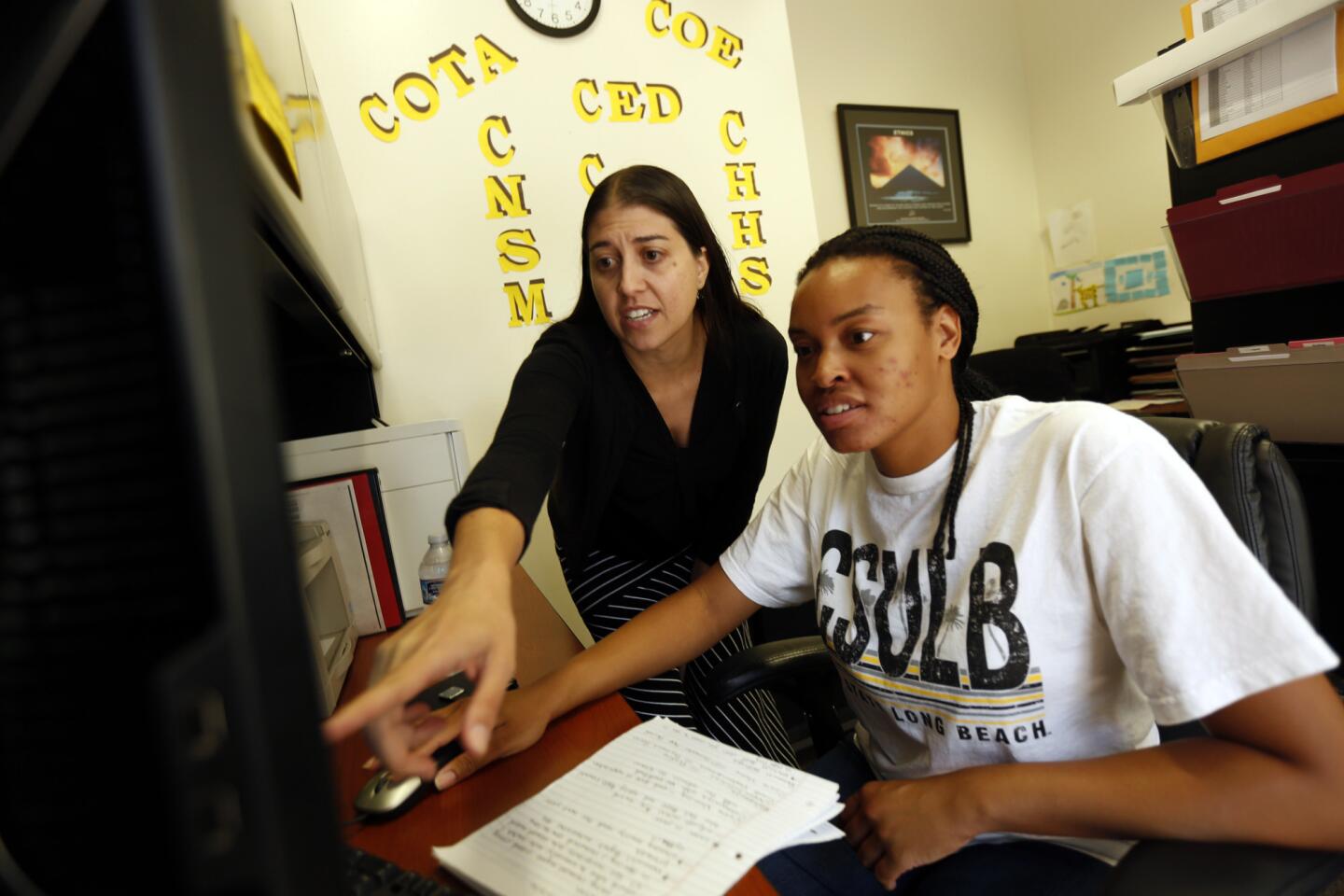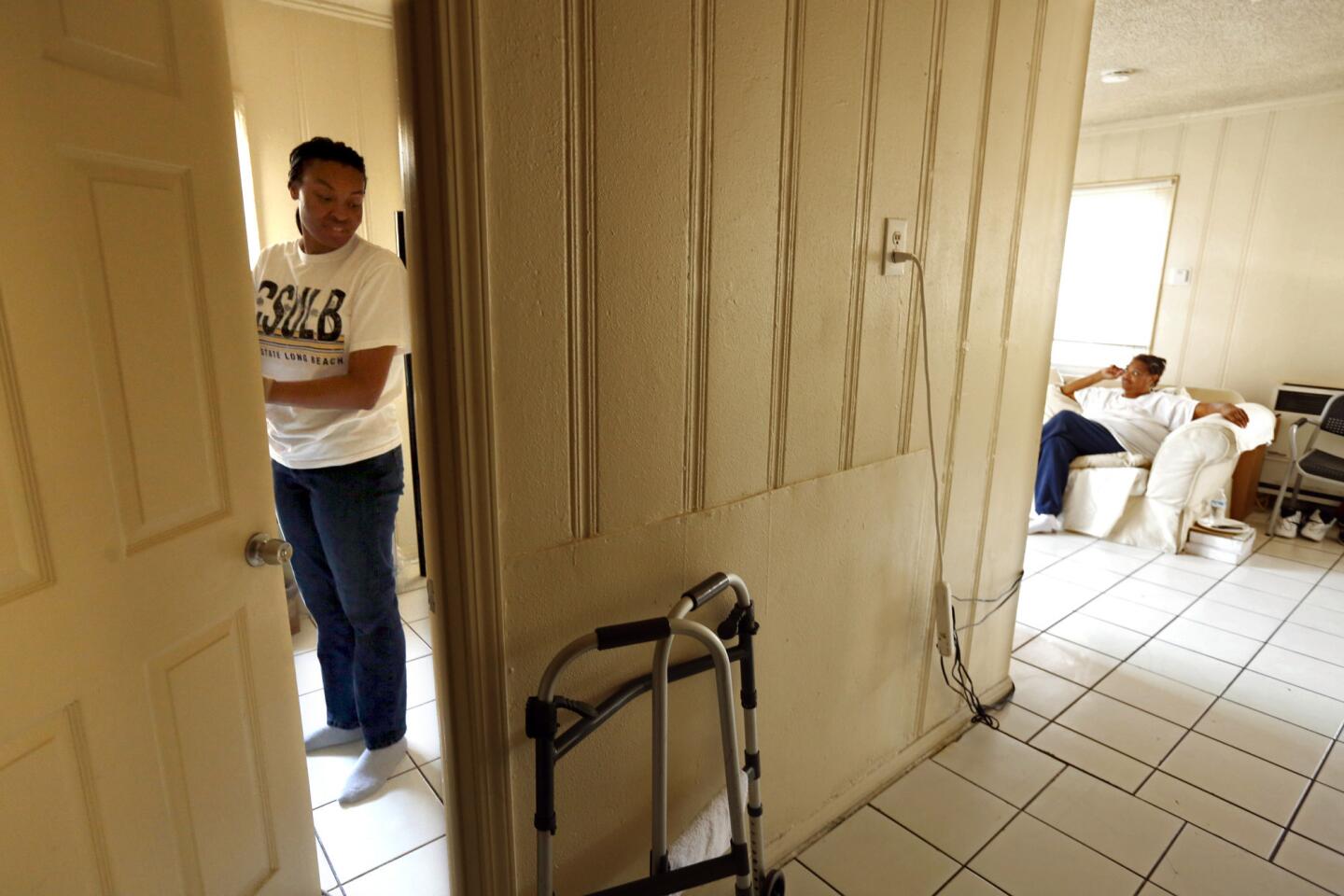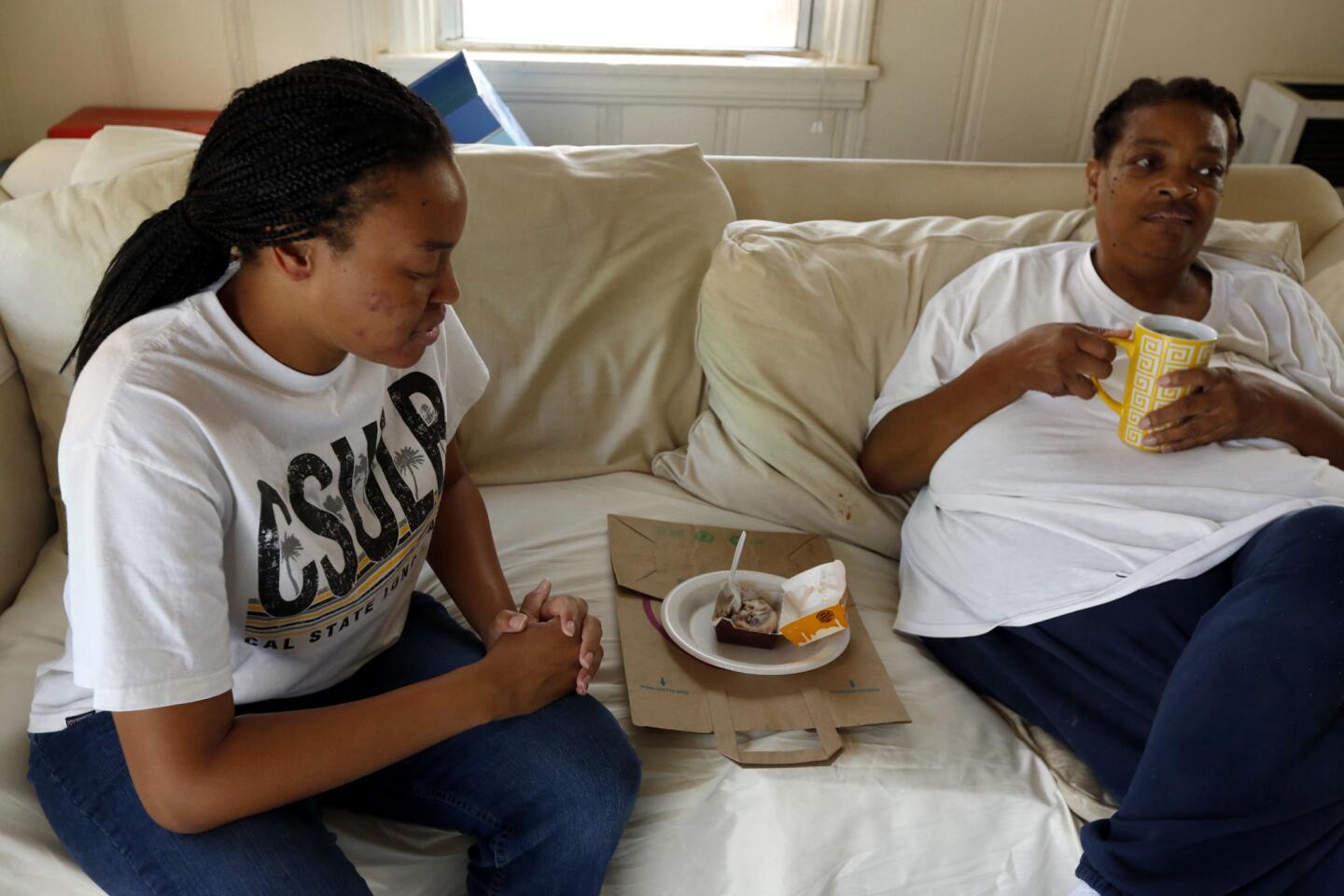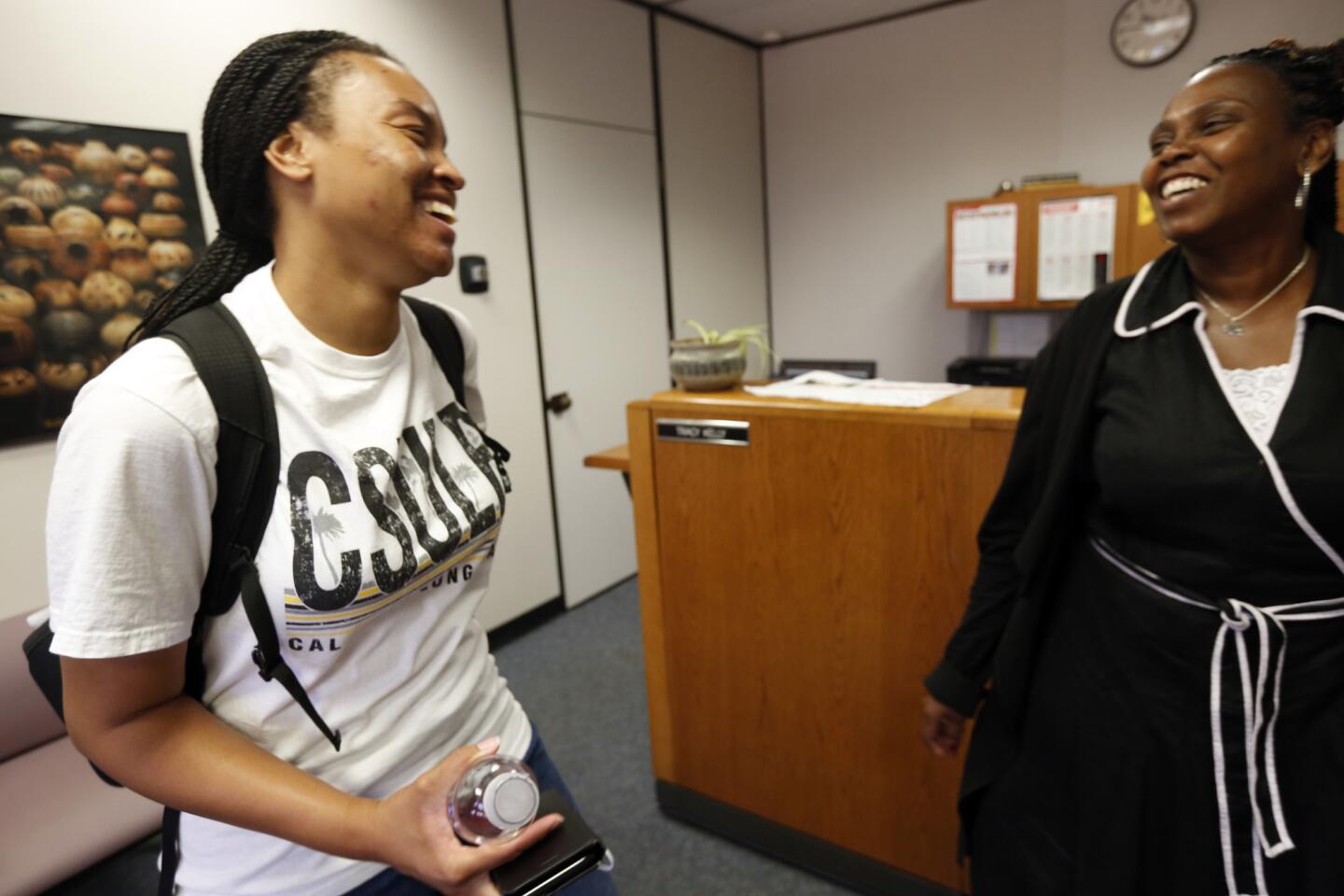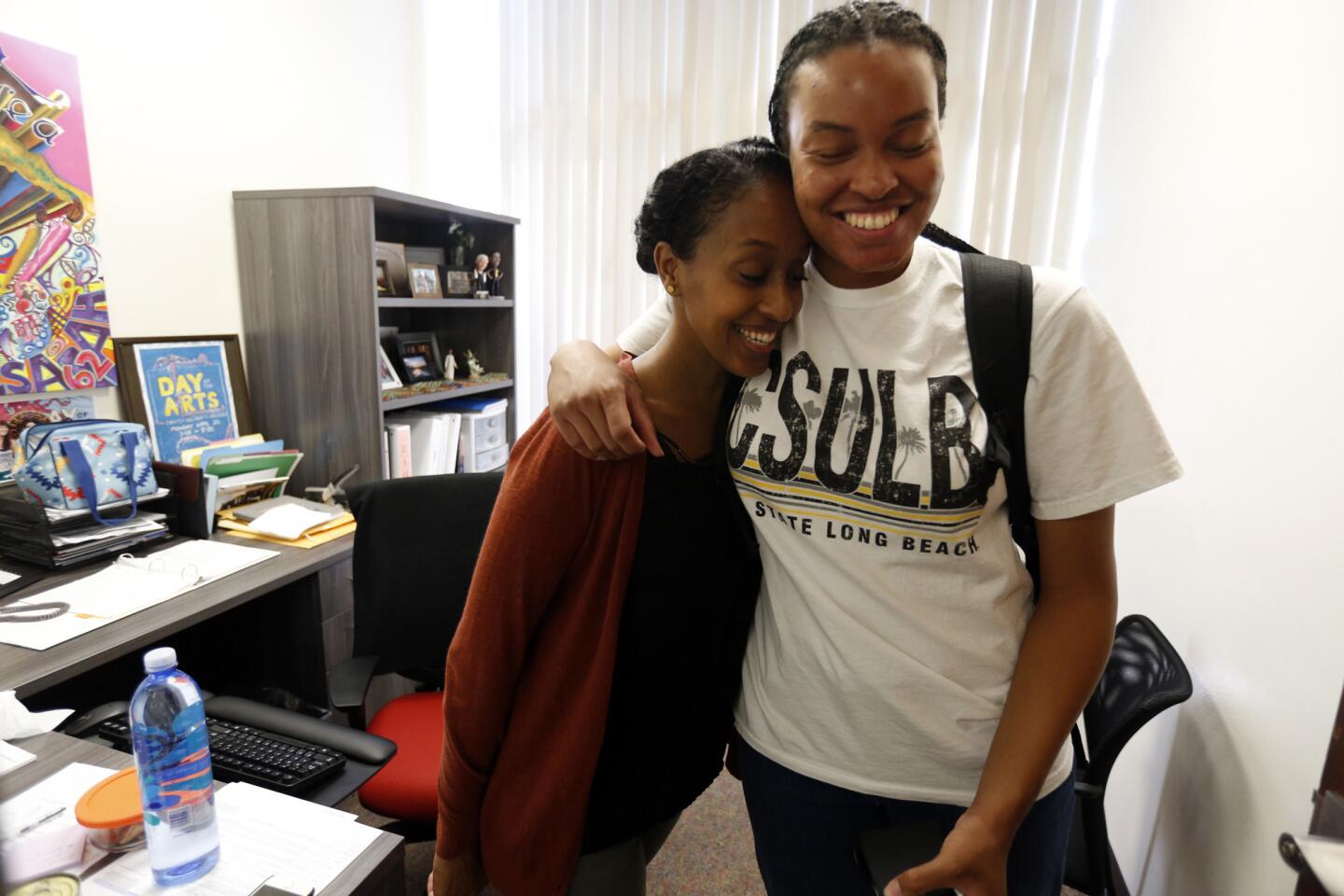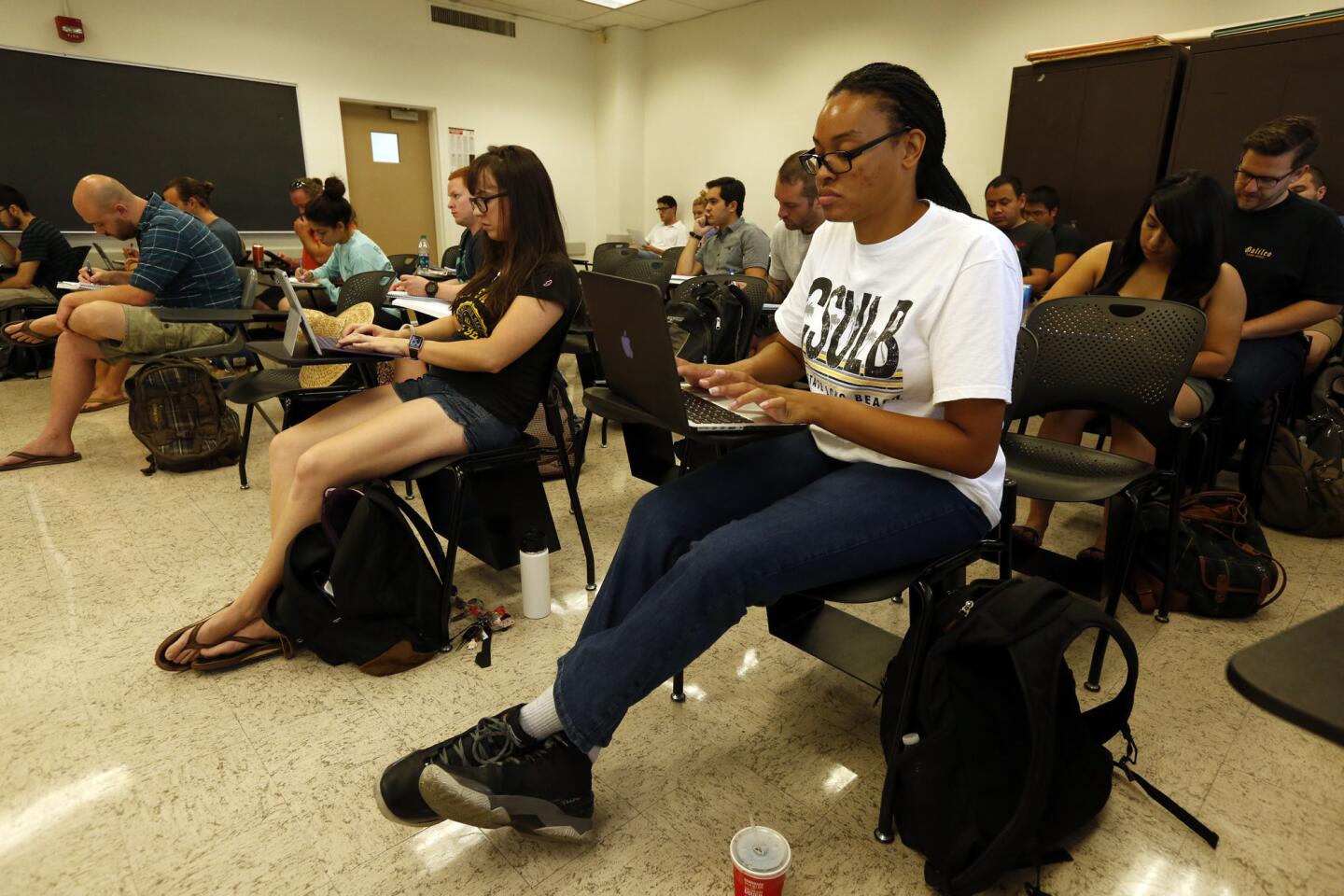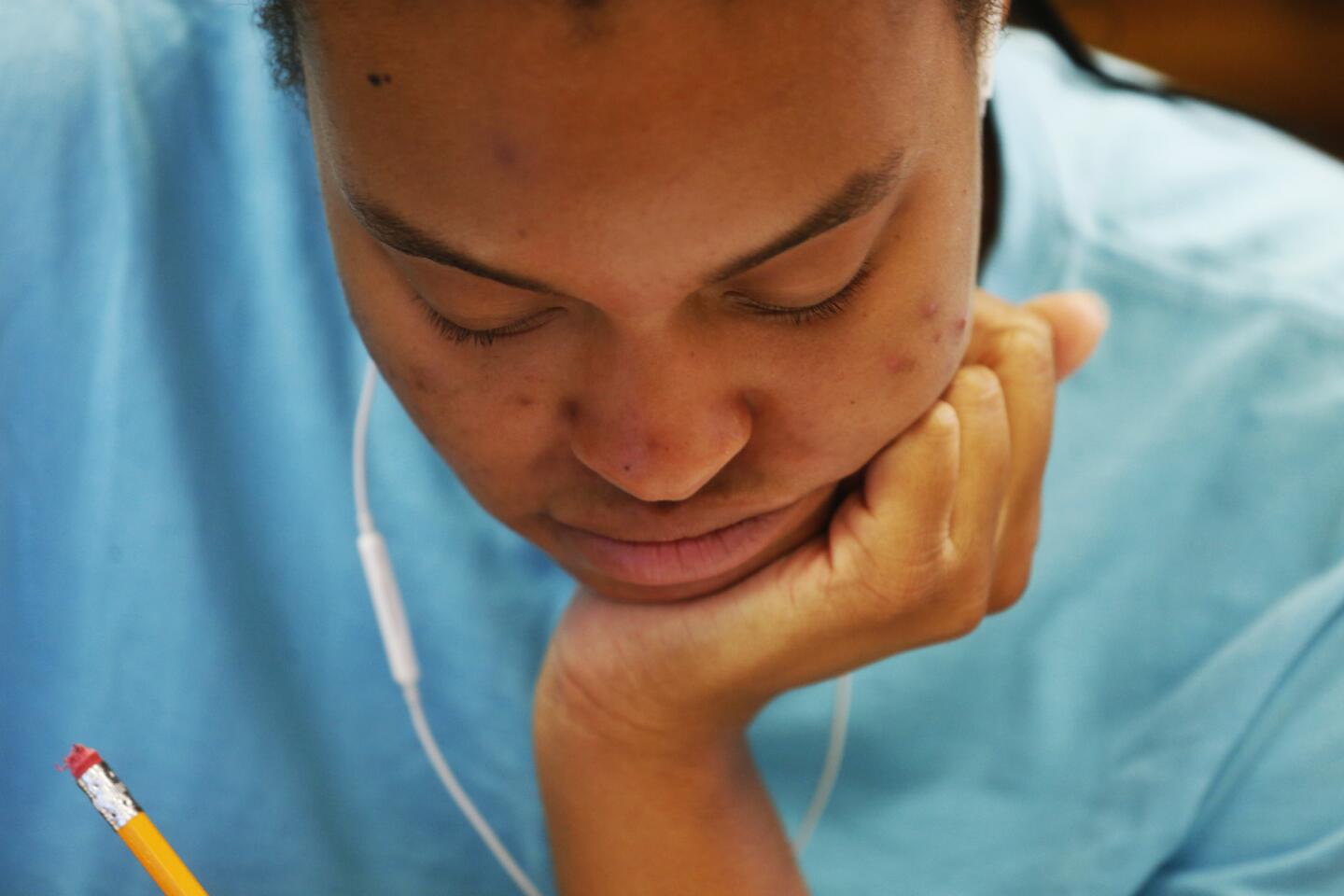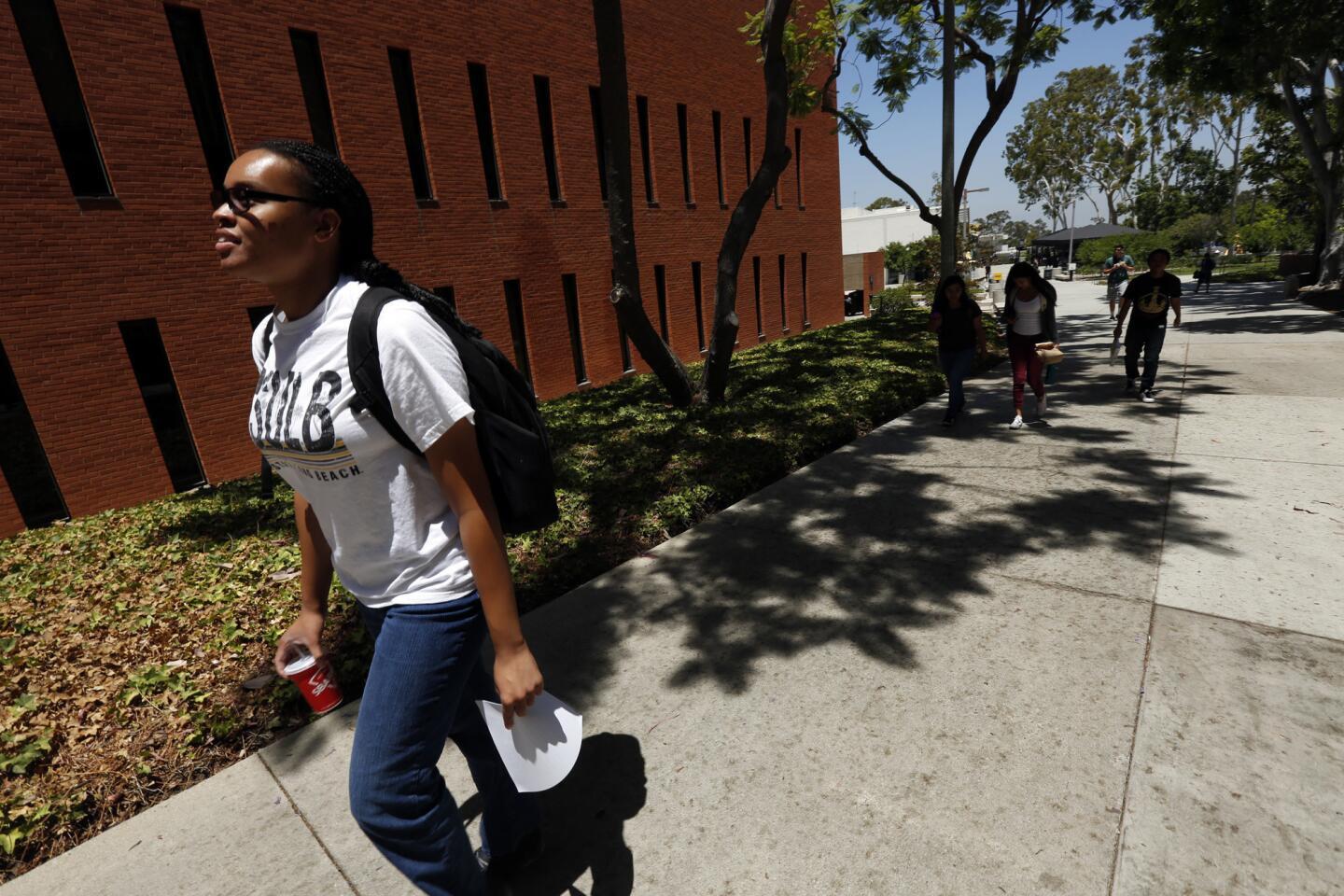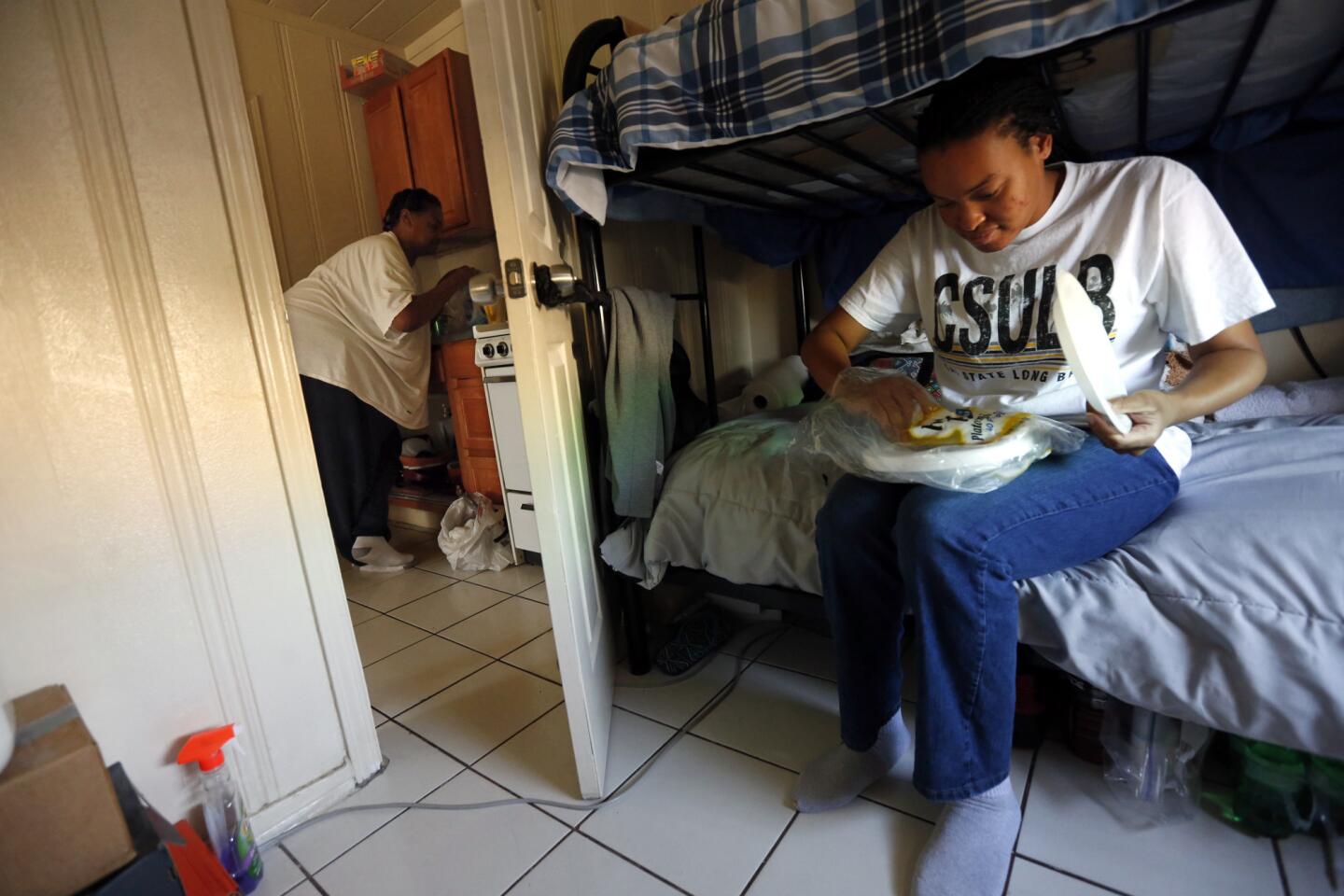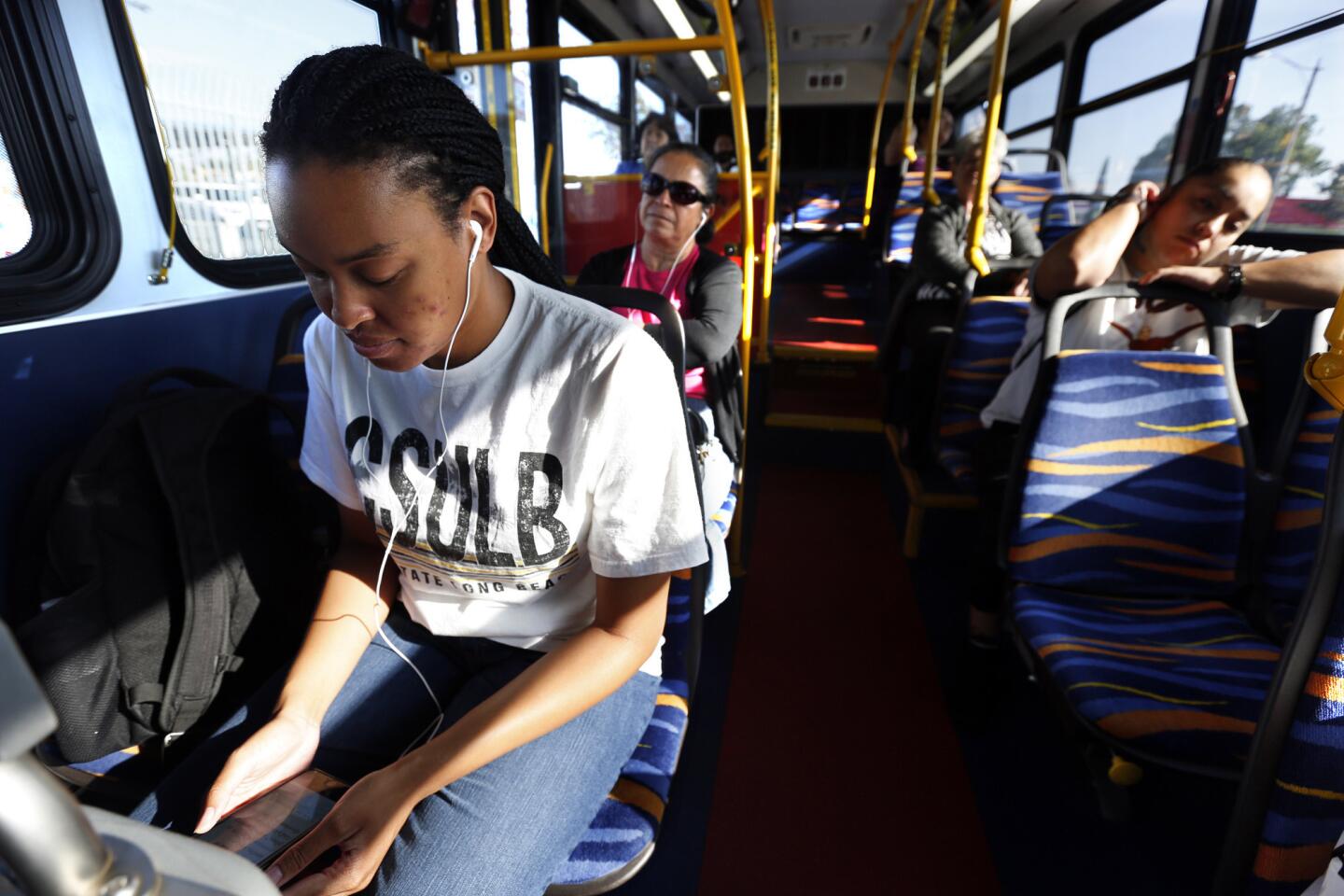At Cal State, student homelessness has been hidden until now

Cal State is making efforts to identify and help its homeless students.
- Share via
Racing from her last class of the day at Cal State Long Beach, Shellv Candler had about an hour to get to Wilmington. Her mother was trying to save her a bed at the Doors of Hope Women’s Shelter, but curfew was 6:45 sharp.
The college student’s commute by bus and train was stressful. But she and her mother had been through worse. The foreclosure of the family home. Evictions. Relatives who could give them shelter for only so long. Some nights, with nowhere to go, they’d ridden the bus until daylight. Once they’d slept in a hospital morgue.
Six classes from graduating, Candler persevered.
“There were times I thought about dropping out,” she said. “But going to school was my escape — to be able to take all that anger, frustration, sadness, disappointment, to take all of that and put it into something as proactive as my education…. This is my chance to be able to do something with my life.”
Cal State, the nation’s largest public university system, has embarked on an unprecedented effort to identify and count its many students who, like Candler, quietly juggle classes, multiple jobs and the anxiety of figuring out where to sleep at night — those who dutifully show up at classes but then curl up in their cars, shower at the gym and shuffle between couches and motels.
The goal, said Cal State Chancellor Timothy P. White, is to build momentum to “provide the necessary support” and change policy — both on campus and in the state Legislature.
Neither data nor social services exist at the higher education level in the way they do for students in kindergarten through high school, which “frankly, limits the attention that’s paid to the issue,” said Barbara Duffield of the National Assn. for the Education of Homeless Children and Youth.
The only official clue to the number of homeless college students in the country is the 56,588 who identified as such on their federal financial aid applications — a number that advocates say understates the problem.
Cal State’s initial findings — based on focus groups, student surveys and interviews with faculty and staff — led university officials to estimate that as many as 1 in 10 of the system’s 475,000 students lacked fixed, steady places to sleep at night.
Are so many students really homeless? Perhaps not, by a strict definition — but, said Eric Rice, who teaches social work at USC and has studied homeless youth for 14 years, “we have this very severe idea of homelessness, which is that it’s a schizophrenic adult who’s lying in essentially a nest of dirty clothes and shopping bags. The issue is just much more nuanced.”
Because Cal State is relatively inexpensive — about $5,500 a year, less than most rents in L.A. — some students choose to spend their limited resources on tuition over housing “because that’s a way to get ahead,” he said.
The research conducted by Rashida Crutchfield, who led the initial phase of the Cal State study, illuminated why many students go unnoticed: Ashamed, they don’t seek help, or they don’t see themselves as homeless because they’re not literally living on the street. Some speak out about their circumstances only when they’re about to flunk or drop out or have nowhere else to turn.
The reasons for their troubles vary — violence at home, mishandled financial aid forms, confusing bureaucracy, said Crutchfield, who teaches social work on the Long Beach campus.
Gabe Rosales’ parents kicked him out two days before he started at Cal State Long Beach, after years of fights over his bisexuality. A friend took him in, and he shopped for groceries, cleaned — anything to express his gratitude.
Interested in the stories shaping California? Sign up for the free Essential California newsletter »
“Half my brain was battling schoolwork. The other half of my brain was like, your parents don’t love you and you’re sleeping on a cot,” Rosales said. He searched Google for answers “but I just didn’t know what to look for, I didn’t even know where to begin.”
He eventually found an assistant dean who showed him how to file for independent status on financial aid forms and get a loan. His high school credentials — class president, choir leader — helped him land a job as president of the Residence Hall Assn., which includes a shared room and $300 stipend for the upcoming school year. To pay tuition and everything else, he took two additional jobs, working in a campus office and as a summer camp counselor.
Fearful that this newfound stability could falter, the 18-year-old doesn’t go out, rations his meals and treats his responsibilities with gravitas.
“I have stable housing for the next year, but that’s only a year,” he said. “I don’t know where I’m going to live a year from now.”
Some people dismiss the woes of “the starving college student” or say the problem is wasteful spending on alcohol and lattes, Crutchfield said. “Sometimes people ask me, are these students getting financial counseling? And I say: ‘Well yeah, we can offer them financial counseling, if you can offer financial counseling on how to make $100 last 30 days.’ ”
It can become this domino effect if we don’t catch it and find a way to help.
— Duan Jackson
In the next phase of the study, she said, her team will find and interview many more students after sending out thousands of surveys to all 23 schools.
The findings ultimately will help Cal State launch intervention support programs on every campus, Crutchfield said. Eleven — including Long Beach — offer some sort of support, such as food pantries or emergency housing. Others have a long way to go.
A number of higher-education bills have also been moving through the California legislature, including one to designate homeless point persons on state campuses and another to keep some dorms open when classes are out of session.
At Long Beach, academic advising director Duan Jackson — once a neighbor of Candler’s — remembers the day Candler came into her office and confided that she and her mom would lose their apartment if she didn’t drop out and get a full-time job. Holding back tears, Jackson started spinning through all the campus contacts she’d made in 26 years, hoping someone knew how to help.
Her calls and emails led her to Carol Menard Fulthorp, assistant dean of students, whose team had put together a budding emergency support program. They gave Candler a temporary dorm room to get through finals. Students’ meal donations were loaded onto her dining card. Menard gave Candler an office job.
The Student Emergency Intervention and Wellness Program, running on donations and a campus grant, so far has helped 137 students, including Candler and Rosales. The initiative also has gotten nine students jobs and recently added a food pantry and hotel vouchers.
“It can become this domino effect if we don’t catch it and find a way to help,” Jackson said of the kind of struggle she saw Candler go through.
Candler and her mother now stay in a transitional home in north Long Beach, which they found after their time was up at the shelter. The two cram into a room smaller than most walk-in closets. She sleeps on the top bunk for $250, her mother on the bottom for $300. A third roommate lives an arm’s width away.
Candler squeezes in three jobs between classes to support herself and her mother, who’s been out of work since she had surgery to replace a femur with a metal rod and was put on disability because of an adrenal gland hemorrhage.
The bills add up. The beds eat up one whole paycheck, and $187 a month in food stamps stretches only so far. Then there’s about $4,000 a semester for tuition and books, and doctor visits that Candler insists on attending so she understands which medicines to give her mother. Not to mention phone bills and the Wi-Fi, which Candler finally sprung for because her late commutes home from the library worried her mother.
See the most-read stories this hour »
When it gets too overwhelming, she thinks about how much easier it would be to make ends meet if she dropped out and got a full-time job.
“You are not giving that up, this is your dream,” her mother says, reminding her of her journey from community college to Long Beach, where she is studying to be a history teacher.
“Mom,” she says, “ you need to be taken care of.”
One recent morning, Candler helped her mother out of the bottom bunk, selected an outfit from one of five storage bags stacked in the corner, then took two buses to get to campus, where she clocked a full morning of work before heading to her three-hour history class — an intensive summer course that counts toward both her major and the teaching credential program.
“I’m this close to graduating,” she said. “I‘m not going to let anything stop me.”
Follow me on Twitter @RosannaXia for more higher education news.
ALSO
L.A. City Council asks Gov. Brown to declare homelessness a statewide emergency
Is the shift to permanent housing making L.A.’s homelessness problem even worse?
More to Read
Sign up for Essential California
The most important California stories and recommendations in your inbox every morning.
You may occasionally receive promotional content from the Los Angeles Times.
